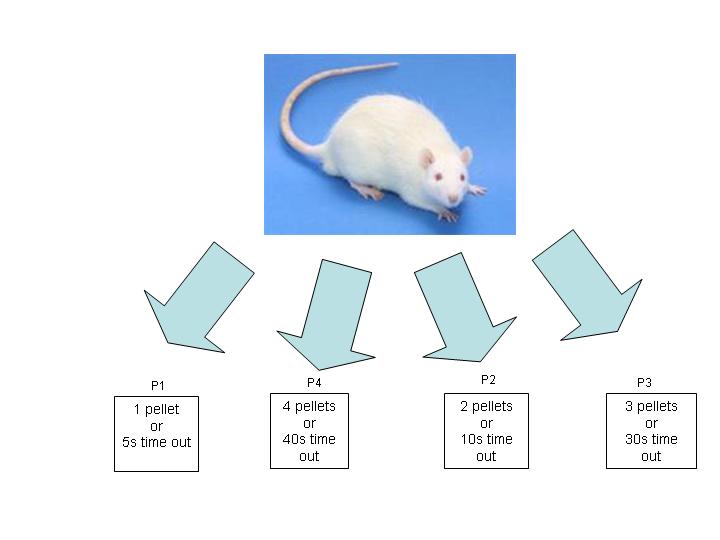The WAGER, Vol. 14(9) – Turning rats into gamblers: Modulating gambling behavior using laboratory animals.
Animal models of human behavior help scientists to understand pathology and develop new drugs. This week’s The WAGER reviews a study that examines an animal model of gambling behavior (Zeeb, Robbins, & Winstanley, 2009). Zeeb et al. sought to determine if rats are capable of “playing the odds” and if altering their brain chemistry (e.g., to mimic the neurochemistry of human gamblers) changes the rats’ decision-making, which according to the authors was a proxy for gambling strategy.
Method
- Investigators trained rats (N = 32) to choose between four trays (P1 – 4) to nose-poke for food (see Figure 1).
-
- Each time a rat “won”, it received one or more sugar pellets as a reward.
- Each time it “lost”, there was a timeout during which it could not play.
- In terms of long-term gain, the optimal choice was to choose P2, which was getting 2 sugar pellets with moderate waiting time.
- P1 represented the choice with the lowest reward (1 pellet) and the lowest probability of timeout; P4 was the choice with the highest reward (4 pellets) and the highest probability of timeout.
- After at least one week of stable baseline behavior, the researchers injected various drugs that affected (i.e., increased or decreased) the level of dopamine in brain to alter the animals' brain chemistry to mimic that of problem gamblers. Examples of drugs are:
-
- Amphetamine:
potentially increases the level of dopamine in the brain. - Eticlopride:
blocks dopamine receptors. - SKF
81297: triggers dopamine response by the brain cell.
- Amphetamine:
- Investigators conducted repeated measures ANOVA to measure how the preferences were changed following the drug injection.
Figure 1. Trial structure for the Rat Gambling Task.*
Notes:* The location of the trays was counterbalanced across rats. A picture represents one possible setting.
Results
- At baseline, animals consistently showed a preference for the optimal choice (P2), associated with a modest gain and moderate punishment.
- Amphetamine significantly increased selection of the non-optimal choice P1 (p < .01), which is associated with the least punishment but also with the least reward.
- Eticlopride significantly increased selection of the optimal choice (p < .01).
- SKF 81297 significantly increased the selection of P4 (risky with largest probability of punishment) and significantly decreased the selection of the optimal choice (p < .01).
Limitations
- The "Rat gambling task" is not a complete analogy for human gambling behavior (e.g., rats cannot really “lose” food).
- The "decision making" task is not necessarily a proxy for gambling.
- It is not clear if dopamine leads to the avoidance of punishment or awareness of rewards.
- It is not clear if rats are relying on memory to make their choice, rather than basing their preference on the perception of risk or punishment tolerance.
Conclusion
This study indicates that rats are capable of ‘playing the odds’. Moreover, they seem to be “risk-averse” animals, similar to human beings. The obtained data suggest that changing brain chemistry produces subsequent changes in animals “similar-to-gambling” behavior. Specifically, dopaminergic agents (drugs that influence dopamine activity in brain) can impair or improve gambling performance. The results imply that high levels of dopamine might pre-dispose non-optimal decision making, creating a risk factor for gambling-related problems. The mechanism of dopamine as a risk factor is not yet clear. However, the results are consistent with previous studies that found dopamine treatment to increase gambling drive among human patients (Abler, Hahlbrock, Unrath, Gron, & Kassubek, 2009). Taken together, these findings indicate that the rats gambling task might be a useful tool to study biological aspects of gambling.
-Julia Braverman
What do you think? Please use the comment link below to provide feedback on this article.
References
Abler, B., Hahlbrock, R., Unrath, A., Gron, G., & Kassubek, J. (2009). At-risk for pathological gambling: imaging neural reward processing under chronic dopamine agonists. Brain: A Journal of Neurology, 132(9), 2396-2402.
Zeeb, F. D., Robbins, T. W., & Winstanley, C. A. (2009). Serotonergic and Dopaminergic Modulation of Gambling Behavior as Assessed Using a Novel Rat Gambling Task. Neuropsychopharmacology, 34(10), 2329-2343.